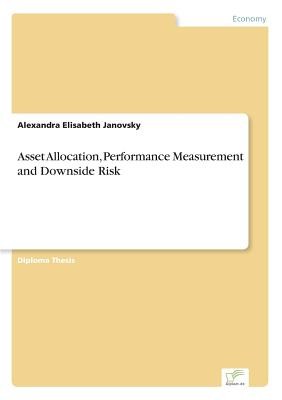
- We will send in 10–14 business days.
- Author: Alexandra Elisabeth Janovsky
- Publisher: Diplom.de
- Year: 2001
- Pages: 124
- ISBN-10: 3838632214
- ISBN-13: 9783838632216
- Format: 14.8 x 21 x 0.7 cm, softcover
- Language: English
- SAVE -10% with code: EXTRA
Asset Allocation, Performance Measurement and Downside Risk (e-book) (used book) | bookbook.eu
Reviews
Description
Inhaltsangabe: Abstract: Investors should not and in fact do not hold a single asset, they hold groups or portfolios of assets. An important aspect in portfolio theory is that the risk of a portfolio is more complex than the risk of its components. It depends on how much the assets represented in the portfolio move together, that is, on the correlation between the single assets. In portfolio theory, there are several definitions of risk: First of all, the Capital Asset Pricing Model (CAPM) relies on the beta factor of an asset relative to the market as a measure for the asset's risk. On the other hand, also downside risk can be used in order to determine a portfolio's risk. The kind of risk in question is market risk, which is the risk of losses arising from adverse movements in market prices or rates. Market risk can be subdivided into interest rate risk, equity price risk, exchange rate risk and commodity price risk. For many investment decisions, there is a minimum return that has to be reached in order to meet different criteria. Returns above this minimum acceptable return ensure that these goals are reached and thus are not considered risky. Standard deviation captures the risk associated with achieving the mean, while downside risk assumes that only those returns that fall below the minimal acceptable return incur risk. One has to distinguish between good and bad volatility. Good volatility is dispersion above the minimal acceptable return, the farther above the minimal acceptable return, the better it is. One way of measuring downside risk is to consider the shortfall probability or chances of falling below the minimal acceptable return. Another possibility is measuring downside variance, i.e. variance of the returns falling below the minimal acceptable return. As a consequence, downside variance is very sensitive to the estimate of the mean of the return function, while standard deviation does not suffer from this problem. Thus the calculation of downsid
EXTRA 10 % discount with code: EXTRA
The promotion ends in 18d.21:06:43
The discount code is valid when purchasing from 10 €. Discounts do not stack.
- Author: Alexandra Elisabeth Janovsky
- Publisher: Diplom.de
- Year: 2001
- Pages: 124
- ISBN-10: 3838632214
- ISBN-13: 9783838632216
- Format: 14.8 x 21 x 0.7 cm, softcover
- Language: English English
Inhaltsangabe: Abstract: Investors should not and in fact do not hold a single asset, they hold groups or portfolios of assets. An important aspect in portfolio theory is that the risk of a portfolio is more complex than the risk of its components. It depends on how much the assets represented in the portfolio move together, that is, on the correlation between the single assets. In portfolio theory, there are several definitions of risk: First of all, the Capital Asset Pricing Model (CAPM) relies on the beta factor of an asset relative to the market as a measure for the asset's risk. On the other hand, also downside risk can be used in order to determine a portfolio's risk. The kind of risk in question is market risk, which is the risk of losses arising from adverse movements in market prices or rates. Market risk can be subdivided into interest rate risk, equity price risk, exchange rate risk and commodity price risk. For many investment decisions, there is a minimum return that has to be reached in order to meet different criteria. Returns above this minimum acceptable return ensure that these goals are reached and thus are not considered risky. Standard deviation captures the risk associated with achieving the mean, while downside risk assumes that only those returns that fall below the minimal acceptable return incur risk. One has to distinguish between good and bad volatility. Good volatility is dispersion above the minimal acceptable return, the farther above the minimal acceptable return, the better it is. One way of measuring downside risk is to consider the shortfall probability or chances of falling below the minimal acceptable return. Another possibility is measuring downside variance, i.e. variance of the returns falling below the minimal acceptable return. As a consequence, downside variance is very sensitive to the estimate of the mean of the return function, while standard deviation does not suffer from this problem. Thus the calculation of downsid


Reviews